In Search of Ann Arbor Artists: A Sojourn

An artist in a cherrypicker whitewashes the brick facade of The B.O.B. to prep for painting a mural there. The Big Old Building, known as the "Bob," will be an ArtPrize venue for more than 150 artists, including eight from Ann Arbor. (Photo by Dave Askins.)
Starting on Wednesday and running through Oct. 10, the city of Grand Rapids is turning itself into one huge urban art gallery. The concept is ArtPrize – an art competition open to anyone who wants to enter, at any location offered up as a venue, with a $250,000 top prize that’s awarded by people who actually visit the city and take the time to vote. Another $200,000 will be given out in smaller amounts, also based on votes.
It’s about as public as art can get.
The Chronicle has been covering Ann Arbor’s own public art initiatives, reporting on the monthly meetings of the Ann Arbor Public Art Commission, which oversees the city’s Percent for Art program, and tracking the saga of German artist Herbert Dreiseitl, who’s being commissioned – for over $700,000 – to make three art installations at the new municipal center. So the question of how another city in Michigan is promoting public art was a natural one to pursue.
That led The Chronicle to Grand Rapids last weekend.
Over two dozen Ann Arbor area artists are among the 1,200 or more who’ve entered the ArtPrize competition. We hoped to observe artists setting up their work prior to Wednesday’s opening, and to motivate others to make the two-hour trip up I-96 to check out what happens when a city opens itself quite dramatically to art. Here’s a sampling of what we encountered.

The frame of a photo by John Harrison reflects a man sitting outside Biggby Coffee, which serves as a venue for ArtPrize. (Photo by Dave Askins)
An Unlikely Venue: Biggby Coffee
ArtPrize organizers are serious when they say virtually any place can serve as a venue: Vacant buildings, hotels, bridges, restaurants and coffee shops. Artist Emir Alibasic, a University of Michigan fine arts student, is scheduled to exhibit his oil paintings at Biggby Coffee at 146 Monroe, but his work hadn’t been mounted when The Chronicle arrived on Saturday.
Still, even in that small shop we found the work of another artist with an Ann Arbor connection: John Harrison, whose “India in Color” series of photographs fill a corner of the room, noted in his artist’s statement that his wife Jen grew up in Ann Arbor.
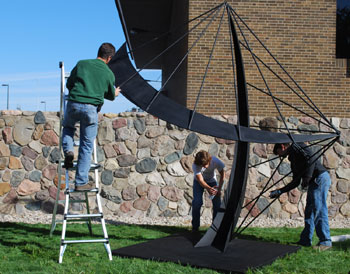
Tim Sikma, standing on the ladder, uses black spraypaint to cover up handprints on the sculpture made by his son, Nicholas Sikma of Fenton, far right. The artist's brother, Zach Sikma, helps wipe down the welded steel artwork, which is exhibited outside of the Grand Rapids Press building. (Photo by Dave Askins.)
Getting Rid of Handprints: A Guide
Walking north on Monroe, we passed the building that houses the Grand Rapids Press – part of the chain that owned the former Ann Arbor News – and saw about a half-dozen people tending to a large steel sculpture. One of them appeared to be … spraypainting? Yes, that was definitely spraypaint. The artist, Nicholas Sikma of Fenton, was getting a hand from his dad, Tim Sikma, who was standing on a ladder and applying black spraypaint to the welded steel. The aim was to cover up handprints made when they’d moved the sculpture into position on a grassy area next to the sidewalk.
By the looks of it, they would have needed to apply their hands firmly to heft the artwork – it took four men, including the artist, his father, his brother Zach and his brother-in-law, Jeff Altoft, simply to shift the piece and pull out the wooden two-by-fours that served as its temporary base. Later, Sikma was going to add a cast bronze disc to the welded steel sculpture.
The Grand Rapids Press building will also be the venue for Ann Arbor artist David Fischer, whose “5 Heads” sculpture is made from blue blown glass.

The Brass Works Building at 648 Monroe, where three local artists will be exhibiting during ArtPrize. (Photo by Dave Askins.)
Chance Encounter with The Mayor
At least three artists with local ties – Josh McVety, Ashley Lieber and Aaron Griffith – are exhibiting at the Brass Works Building at 648 Monroe. But when The Chronicle arrived there on Saturday, the place was impenetrable, locked up on all fronts. At the park across the street, though, was a crowd of blue-T-shirted folks who looked purposeful, so we wandered over. Coincidentally, two TV crews arrived at about the same time, from the city’s Fox and CBS affiliates. The T-shirts and TV coverage indicated that we’d stumbled across the annual Mayor’s Grand River Clean Up Day, and as we chatted with a couple of volunteers, up walked the mayor himself, George Heartwell.
Heartwell said he was “geeked” about ArtPrize. “It’s about more than a big purse for art,” he told The Chronicle. “It’s about the whole community coming together about the Big Idea of art.” The event had spurred conversations throughout the community, he added, with people asking questions like “What role does art play?” and “Does art have to be beautiful?”
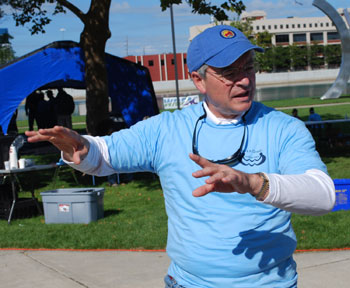
George Heartwell, mayor of Grand Rapids, explains to The Chronicle that you don't have to be a published poet to appreciate art. (Photo by Dave Askins.)
When we asked about his own artistic bent, Heartwell laughed – then revealed that he wrote poetry back in the day. He said he still has a thick file of rejection letters: “They said, ‘You’re a wonderful poet, but your poetry doesn’t sell.’”
But his main influence related to public art came from urban planning work he did in the 1990s with Edi Rama, now the mayor of Tirana, Albania. Heartwell said that Rama, Albania’s former minister of culture, helped him understand how art dignifies and challenges people, and how you begin to see yourself differently because of the art that’s around you.
On a practical level, Rama gets to choose the colors of all new buildings in Tirana, Heartwell reported. Referring to Ann Arbor’s mayor, Heartwell joked: “Me and Hieftje – we’d love that, wouldn’t we?!” [This link, which includes a brief bio of Rama, shows before-and-after photos of a building that's been painted according to Rama's color palette.]
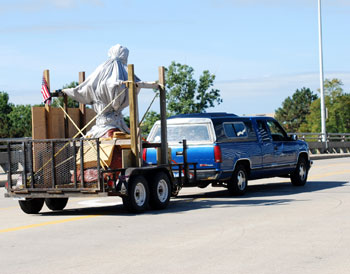
Rob Goodrich's 900-pound sculpture "Eartha, a.k.a. Mother Earth" in transit down Michigan Avenue. (Photo by Dave Askins.)
“Where Can I Unload?”
Heading back south along a walkway that parallels the Grand River, we stopped before crossing Michigan Avenue, a major thoroughfare. A blue pickup, hauling a trailer with something that looked like a large, well-wrapped sculpture, was stopped in the middle of the road in front of us, next to the massive DeVos Place convention center. There was no stoplight there and it’s a fairly busy road, so it seemed clear that the driver was up to something. We hollered, “Are you with ArtPrize?” Rob Goodrich, sitting on the passenger side, hollered back in the affirmative – he was supposed to exhibit on the grounds of DeVos Place, but he didn’t know exactly where, and he was looking for a place to unload.
And indeed it was a sculpture on the trailer, the 900-pound “Eartha, a.k.a. Mother Earth,” sculpted from FossilCrete. Given the circumstances, there was no chance to chat with Goodrich, who’s from Watervliet, Michigan. But we did wish him luck – his work can be found, somewhere, outside DeVos Place.
Mention of DeVos Place is perhaps an appropriate time to note that the DeVos family is underwriting ArtPrize through the Dick and Betsy DeVos Foundation. Their son Rick DeVos is leading the effort. The family is best known as owners of Amway, which is based on the outskirts of Grand Rapids and was founded by Rick DeVos’ grandfather.
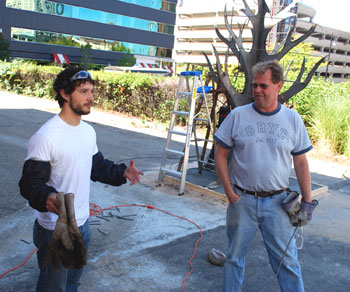
Ann Arbor artist Matt Kelsey, left, and Tom Gammans, a Grand Rapids art teacher, work on The Grand Rapids Family Tree, seen in the background. (Photo by Dave Askins.)
Look, It’s a Tree!
On our way to find the Open Concept Gallery, where Ann Arbor artists Margaret Wyngaard and Kristin Hermanson are exhibiting, we encountered two men – one wielding a welding torch. And in a bit of serendipity that seemed to charm our entire visit, it turned out that the one with the torch was Matt Kelsey, who lives on Ann Arbor’s west side.
Kelsey is the leader of a collaborative ArtPrize effort that involves 30 to 40 art teachers from Grand Rapids. Their artwork – The Grand Rapids Family Tree – is a 10-foot-tall stylistic sculpture of a tree, cut from panels of quarter-inch steel and anchored in a concrete base. Thin rings encircle the branches, and from those will hang braided steel cables with silk ribbons attached. The ribbons – about 3,500 of them – have been signed by people from Grand Rapids, Kelsey said.
The idea was to make a participatory piece that connects people in the community – if they win, all the proceeds will be donated to the Grand Rapids Public Schools. During ArtPrize, there’ll be an interactive component as well: Someone will be stationed next to the tree with extra ribbons, so that passers-by can add their names – as long as they’re from Grand Rapids. You can find this piece at 45 Ottawa Ave., on the east side of a vacant building at Ottawa and Louis Street, which is also an ArtPrize venue.
Post-ArtPrize, Kelsey said he’d love to see the tree find a permanent home in one of the city’s parks. He described it as a “transitory memorial” – the ribbons could be changed to reflect different causes, like pink ribbons for breast cancer awareness and red, white and blue ribbons for Memorial Day.
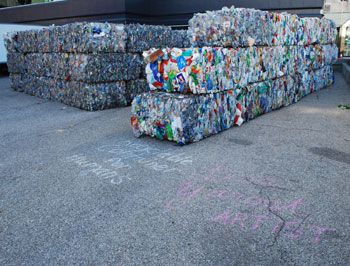
Entrance to the "Recyclable Container for Humans" by Grand Rapids artist Lisa Yarost, who wrote the title of the piece in chalk on the pavement. It's likely that plastic bottles similar to the ones used in this installation were picked up during the Sept. 19 Mayor's Grand River Cleanup Day. (Photo by Dave Askins.)
Olfactory Art
Immediately behind the Grand Rapids Family Tree we noticed what appeared to be bales of trash. It wasn’t absolutely clear that this was an art project – we knew it was Grand River Cleanup Day, for example – so we didn’t check it out. Later in the day, however, in one of the many encounters we had with others who were meandering around downtown looking for ArtPrize installations, someone mentioned that they’d seen the bales being hoisted into place by a crane. That, we had to see.
By the time we returned, we’d missed the crane but saw the end result of its work: More than 100 bales had been stacked to form an enclosure reminiscent of a fort, if that fort had been built by a giant kid living in a dump. Each bale is made of compressed plastic bottles, not yet recycled but clearly on their way. And because many of the bottles had contained detergent or fabric softener, the enclosure – titled “Recyclable Container for Humans” – smells distinctly like a laundry room.
In a work statement posted online, Lisa Yarost, a Grand Rapids artist, explains the piece this way:
Every day we purchase, consume, and dispose of more items than we ever realize, without considering the resources and energy required to manufacture, distribute, and the dispose of the items upon which our lifestyle of disposability is constructed.
What if it all came back?
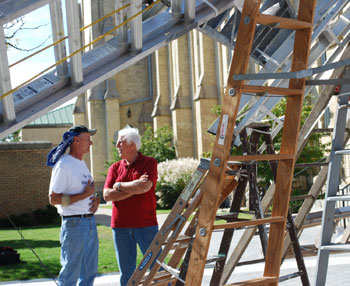
Charlie Brouwer, left, talks with a visitor to his art installation, "Rise Up Grand Rapids." The ladders used to build the sculpture are mostly borrowed from people in the city. (Photo by Dave Askins.)
Lending Ladders
Recycling of a different sort was a theme in another ArtPrize installation in the courtyard of St. Andrews Cathedral. We ventured there not because Charlie Brouwer was an Ann Arbor artist, but because several people we encountered on our walk around downtown had recommended his project, “Rise Up Grand Rapids.” Brouwer was using old ladders – including some he was borrowing from the city’s residents – to build a dome about 25 feet high and 50 feet wide.
In his artist’s statement, Brouwer describes the use of ladders as a metaphor for hope: “We depend on each other – trust is needed in borrowing, lending & returning – the ladders in my structures need each other to stand. Like people they can only transcend and achieve with the help of others.”
He told The Chronicle that as he estimated how long it would take him to complete the installation, he factored in the amount of time he’d probably spend talking to people who passed by – that was part of the project, too. We witnessed just such an occurrence. A woman and her two daughters approached Brouwer – the woman had seen a write-up about his project in the Grand Rapids Press, and had recognized him as her former art teacher. She stopped by to say hello.
Local Artists at ArtPrize
We’d encourage you to stop by and say hello to the local artists who’ll be competing in ArtPrize – or at least, check out their work. Here’s a list of Washtenaw County artists compiled for The Chronicle by Michael Flynn. Links go to their ArtPrize information, laying out exactly where in Grand Rapids you can find their art.
Emir Alibasic
Scott Allen
Dianne Austin
Shonda Bottke
John Braman
Rick De Troyer
David Fischer
Michael Flynn
Aaron Griffith
Kristin Hermanson
Matt Kelsey
Heidi Kraepel
Heidi Kumao
Ashley Lieber
Tad McKillop
Josh Mcvety
Anne Mondro
Nawal and Karim Motawi
Kirsten Neelands and Stephen B. Proctor
Madalina Nicola
Washington Osler
Margaret Parker
Mary Potts
Denise Rohde
Jeff Salter
Jaye Schlesinger
John Schwarz
Matthew Shlian
Mike Sivak
Joshua Ray Smith
Leslie Sobel
Patrick Thompson
Mark Tucker
Cathy Vanvoorhis
Margaret Wyngaard
Additional Photos
-
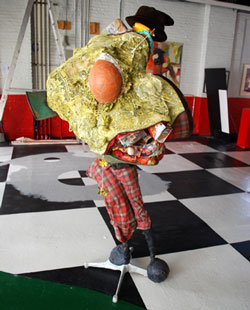
A sculpture by Steve Baibak of Lansing. The vacant building on Michigan Avenue is being sponsored by Michigan State University for exhibits by its alumni and students. We did not see an equivalent venue specifically for University of Michigan artists. (Photo by Dave Askins.)

A large table and chairs sit atop the tressel of Blue Bridge, a pedestrian walkway over the Grand River. The artwork by Sarah Grant is titled "The Furniture City Sets the Table for the World of Art." (Photo by Dave Askins.)
This mosaic by Tracy Van Duinen, left, will be a permanent installation at the Grand Rapids Children's Museum. Van Duinen told The Chronicle that if he wins the prize, he'll have to make another comparable mosaic. A condition of winning is that your artwork is donated to the city – and this piece can't be moved. (Photo by Dave Askins.)

Chelsea artist Heidi Kraepel will be exhibiting her mixed media work in the Ledyard Building, at 125 Ottawa NW. (Photo by Dave Askins.)





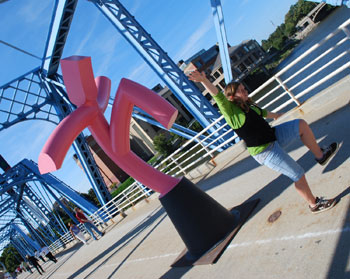

Maybe the people in the AAPAC can learn a few things about how to run an arts program from our conservative friends in Grand Rapid. Think of all the attention art and the city would have received if they only they had let the Courts-Police building project be open to outside proposals with the $700K+ costs.
Guess we’re just backwater hicks in comparison to GR.
“conservative friends in Grand Rapid”
That’s a laugh.
I think we have something to learn from our neighbors. If we can’t come up with something equally visionary, we should at least borrow what Grand Rapids has demonstrated. If we can’t lead at least we can follow.
Great job, Grand Rapids! Congratulations!
The City of Grand Rapids (as opposed to the surrounding areas) is not as conservative as you might think. Sure, they don’t have a Hash Bash, but it is a very pleasant small city with a very vibrant arts and cultural scene that has done a lot of innovative things over the years. There are a lot of lessons that can be learned from visiting Grand Rapids and I encourage our local elected officials and interested residents to do so regularly.
Hey, where is everybody? There is life beyond the City & County budgets, you know!
Mary and Dave,
Thanks for coming to cover ArtPrize in Grand Rapids. All of us here are very proud of what’s happening. The city is buzzing as we near the opening date. It is amazing what can happen when art happens. Grand Rapids certainly has a reputation for being conservative, but when it comes to arts, it’s anything but conservative. Remember, this is the city that had the first ever National Endowment for the Arts project — The Alexander Calder sculpture that has become the symbol of our city (literally). Grand Rapids is a warm and open place. We welcome everyone from the Ann Arbor area to see what our city is all about.
Each day I am surprised at all the happenings with this event. I have followed it from the start and I look forward to the developments of the next day. For sure each next day will have it’s developments as you begin to see what effort has been poured into it.
When it comes to really creative thinking about the arts and its connection to the city, Ann Arbor is more often the imitator than the innovator.
Grand Rapids ArtPrize is a great example of what can happen when leaders reach beyond the elites to embrace inclusivity and creativity.
I’ve got to admit it. Grand Rapids efforts sure beat the graffiti that typifies Ann Arbor’s “art” scene.
How about some of you visionaries out there coming up with something that leverages Ann Arbor’s competitive advantages. Maybe some kind of event that emphasizes technological innovation, life sciences or engineering. It would be great if it worked into helping create economic opportunities.
Come on, with all of the brains out there someone must have some ideas.
Just for the record, I was tossing out our ‘conservative’ friends as a joke /compliment. We have this world class idea in Grand Rapids but our local arts mafia has come up with ART on bicycle racks, a lame German water garden that is as trendy and plays to the audience rather than challenging them and a world view of art that would be safe as milk thirty years ago.
Grand Rapids deserves a tip of the hat. Ann Arbor could learn lots from this. But probably won’t.
Grand Rapids has been doing lots of great art activities for years so this initiative should come as no surprise to those who follow arts activities.
That said, there’s one huge difference between Grand Rapids and the Ann Arbor area that I think most commentators have failed to note. Namely: money. ArtPrize would not happen if the DeVos Family Foundation were not supplying the leadership funds to provide about $500,000 in prize money (and that’s not counting the administrative costs). Ann Arbor has no such foundation with that kind of deep pocket willing to support the arts. Think about it for a second: in Flint, there’s the Mott Foundation and that’s why there are institutions like the Flint Center for the Arts. In Kalamazoo, there’s the Gilmore Foundation that sponsors the internationally recognized Gilmore Keyboard Competition. In Ann Arbor, we limp along with the generosity of individual businesses, people, and the Ann Arbor Area Community Foundation which has about $25,000 to grant to the arts annually.
It’s easy to complain that the art bicycle racks are lame but without funding, you get what you can afford. I’m not sure that it’s a case that Ann Arbor can’t learn from Grand Rapids as much as Ann Arbor doesn’t have the financial resources to accomplish the kind of spectacular attraction that ArtPrize is turning out to be. (And for those of you who like to be cynical, don’t be fooled. I’m sure ArtPrize was conceived not simply as a wonderful way of showcasing local talent, but as an ingenious strategy for capturing thousands of dollars of media attention, rebranding Grand Rapids as a happening place, and shedding the city’s “conservative” image.)
So, after all that, I sincerely hope that all of you who are concerned about Ann Arbor’s artistic future will make a point of coming to 2 meetings the Arts Alliance will be holding to develop a strategy for cultural development in Ann Arbor. These meetings will take place from 4:00 – 5:30pm on Oct. 1 and Oct. 12 in the Ann Arbor District Library, 343 South Fifth Ave. These meetings build off the Washtenaw County Cultural Master Plan that the Arts Alliance released in October 2008 and aim to create a cultural plan that specifically addresses the concerns and interests of Ann Arbor. We’ve created customized plans for the communities of Chelsea, Dexter, Manchester, Milan, Saline, and Ypsilanti and now it’s time to finalize a plan for Ann Arbor. If you’d like to see these plans, please visit our website: link
There’s been lots of passion in this thread – I really hope you’ll join us and share this passion in a way that can help chart an actionable course for the future. (Let’s face it, talk is cheap – action is harder to produce.) In particular, I really hope Mr. Goldsmith will join us. From his many comments about public art, I can tell this is an important issue to him and this is a way to help turn ideas into reality.
If you have any questions about the cultural plan project or the Arts Alliance, do contact me! Our arts community will only be as strong and vibrant as we make. My email is tamara@a3arts.org and my phone is 734/213-2566.
Tamara
Your analysis seems to be on target. You could have added that the Ann Arbor Art Fair would not exist had it not been for a bunch of merchants looking to increase their traffic in the 1960′s. That was also an “ingenious strategy for capturing thousands of dollars of media attention” in addition to putting a few dollars in the merchant’s till. Crass–but the Art’s community has been benefiting from it for a long time.
Your analysis also offers guidance for a course that could reinvigorate the Ann Arbor Art Scene. We know the ART is already here as evidenced by Mary’s citation of the Ann Arbor Artists in Grand Rapids. What’s not here is the money. So it would seem to me that a major creative focus of the Arts Alliance should be on devising ways to get some.
The most obvious (and perhaps least creative) strategy is to go after foundations. However, I think the economy and Bernie Madoff beat you to it. A more creative approach would be to partner with someone who has money.
So, how about something that would link Art with Google’s AdSense? Or something that might integrate the artistic community with our new firms in alternative energy or batteries? The list of possibilities is endless. All that is needed is a little creativity in constructing the relationship.
I’m not the creative type in the field of Art so I have nothing specific to offer. But maybe some of the creative energy being poured art works could be redirected for a time. Just a little redirection of thinking could produce a big return for all involved.
Gary, you’re absolutely right about finding new ways of funding the arts. (And let’s note that this means artists as well as cultural organizations. Thanks to the culture wars of the 1990s, there are very few grant opportunities that are even open to artists.)
Even before the economy collapsed last year and Bernie Madoff was unmasked, the cultural sector recognized that our current system for funding arts and culture was broken. So, in the cultural master plan, we have a whole section dedicated to “Capacity Building, Funding, & Investment,” which is a fancy way of saying how can we do a better job of taking care of our cultural organizations. If all goes as planned, the Arts Alliance will launch an initiative in early 2010 to explore new ways of funding our cultural community in Washtenaw County. Right now, each organization goes out on its own asking for money from businesses, individuals, and the foundations that still do have money to give. It’s not a good system, it’s just the way it’s always been done. Our goal is to start with a clean slate and come up with sustainable strategies for support.
Tamara, not to naysay your efforts or intentions, but from a broader perspective it’s the larger economic system that’s broken. Maybe Michael Moore’s new film, Capitalism: A Love Story, will help us see that context so that we start to take a little of our time away from fighting over the scraps and devote some attention to the illegitimate concentration of wealth in our country.
Tamara — I suggest you proceed as planned. Steve is well-intentioned but I think you’ll have more success focusing on local problems rather than trying to change the wealth distribution of the world from the platform of the Ann Arbor Arts Alliance.
I would suggest that some attention be given to direct commercial tie-in’s even if they are distasteful to the purist. Something that promotes a product or service you respect while at the same time supporting the arts wouldn’t be all that bad.
“…Ann Arbor doesn’t have the financial resources…” and yet we have 750,000 dollars to hand over to an artist from Germany to build an installation that, from the tone of community feedback, a relatively small group of people are in favor of. That money would be much better spent on an event like ArtPrize which would bolster support for local and regional artists as well as draw visitors. Perhaps it would be an opportunity to get the schools involved, or even, say, artists who may be homeless (like the soccer team for those who are homeless). To some extent it is not the amount of money we have to spend (although that IS a significant factor) but how it is being spent. I am a supporter of public art and feel that we need to make it more accessable to the community rather than catering to a small group.
Now there’s an idea. Solve the money problem by gathering in more poor folk. Counter intuitive to say the least. One thing about it, it is sure easier than gathering money from people who have it.
I’m with Julia on the money attached to the new city hall project. A water fountain in Michigan? Hello?? Spend that $800,000 on something like the ArtPrize program and make meaningful progress on public art in Ann Arbor. (To be honest, I’m all for spending that $800,000 on ANYTHING but the water fountain….everything about that idea — other than saving the Kamrowski mosaic — smells.)
Suswhit – Lamenting past decisions must be satisfying but is without consequence. Got any ideas on positive steps to move the city forward?
I have to say I’m with Gary. While it can be emotionally satisfying to gripe about past decisions, I’m more interested in learning from past decisions and then moving forward based on that learning. Talk is nice but I’m much more interested in action.
I hope that it’s not to late to make a better decision about the $800,000….
It’s a lot of money….especially with the state budget info coming out of Lansing this week. Spending the $800,000 better WOULD be a way to move the city forward in a positive way.
“too late” gah!!
Susan is right. The Herbert Dreiseitl work and funding for it have NOT been approved yet, just the design costs. So it isn’t too late to vote it down and come up with another use for the funds.
Tamara–Okay, I got an idea. You know I’m interested in furthering the economic well-being of Ann Arbor and the State of Michigan. I see Art as a vehicle. You probably see Art as an end purpose. But maybe the twain does meet.
How about issuing the Arts Alliance a mini-grant? Hey, its a non-profit. Use the grant to drum up funding for some kind of theme event. Say something like “Systems in Ann Arbor” or the like. Use the money to solicit sponsorship from Google, the UofM, Systems in Motion and the like. If you want to stretch it, even smaller companies like mine might be seduced for a few bucks.
You might consider having Artists visit participating companies to get ideas for their original celebratory work. They get to make some contacts with the economic side of Ann Arbor and may even sell a work or two when the event is over.
It seems to me that this kind of win-win-win idea is what might work to everyone’s benefit. Artists get a venue and some contacts. Companies get their work celebrated in Art. The City gets some PR that works into its innovative image. The Arts Alliance gets new friends.
Okay, its a bit “off the wall.” But its a try at a positive step. It sure seems more fun than chasing around trying to reverse past decisions.
It could be a workable idea. In August, the Arts Alliance applied to the NEA (National Endowment for the Arts) to establish a Washtenaw County Cultural Small Grants program to provide cultural groups with small grants, with an emphasis on showcasing the cultural diversity found in our county (as part of the research for the cultural plan, we’ve learned that 91 different nationalities are represented just in our county alone). We applied for this grant to replace the MCACA (Michigan Council for Arts and Cultural Affairs) minigrant program that we currently manage and that we figure will be chopped from the state budget. Anything that can help pay for the arts, I’m in favor of. If we get the NEA grant, I’m going to work on expanding it to make artists eligible to apply as well as organizations. But first steps first…
As of Saturday (Sept. 26), five Ann Arbor artists are among the top 100 ArtPrize vote-getters. They are Diane Austin, Michael Flynn, Matt Kelsey, Heidi Kumao and Matthew Shlian. See the full list at ArtPrize.org.
I spent the entire weekend at ArtPrize with my family, and had an amazing time. This event was brilliantly conceived and executed – not just by its “strategic visionary” benefactor, but by the entire GR community, who invited the world to join in their city-wide celebration. I have no idea if Grand Rapids is normally this awesome, but it left a great impression.
I’m headed to Boulder, CO this weekend for another locally-scoped, but nationally-branded Tech/Food/Music conference that would be right at home here in Ann Arbor: Link. I’m hoping our next Ignite Ann Arbor event is a step in this direction: Link.
These other cities are much more effective in marketing cultural values that are creative, fun, and community-oriented, versus bureaucratic, staid, and institutional – not to pick on anyone, but compare groups in Grand Rapids and Boulder to Ann Arbor DDA and Ann Arbor SPARK for some idea of this. And to drive change, we have Ann Arbor Region Success to rally around. Hrm.
Dug–Amen
Well said.
It was nice to see the Chronicle venture over to my home town to see ArtPrize. Grand Rapids is a remarkable place, due in no small part to some very generous local business people (the number of buildings and cultural sites named for DeVos, VanAndel and Meijer is quite incredible) and an openness to both the visual and performing arts that stems from the installation of the Calder stabile in 1969.
By the way, there was substantial opposition to the Calder in those days. One County commissioner wanted to put a fountain on the spot where the stabile stands today. Like Ann Arbor’s water garden, perhaps?
When I first heard about Art Prize I really didn’t know what to think! The money wasn’t the reason I applied. I didn’t expect to win. I thought why not? It’s a risk but at least someone is doing SOMETHING for art. This has created a lot of dialog about art. The event has been dismissed and praised but TALKED about and that’s good for everyone on many levels. It reminded me a lot of the “happenings” in the 60′s. The freedom and energy was amazing. Did I personally like all the art? Not all of it. I liked much of it and couldn’t believe the range of approaches. Yes, it’s good for the city….they did a brilliant job hosting and planning. They made a ton of money. I don’t think Grand Rapids will be the same after this. I was a little nervous because of the city’s rep. for being ultra conservative. It may still be on some level but i think what they achieved is remarkable. I would encourage Ann Arbor to follow suit if possible. I love my city and making art in my city. An Art Prize Ann Arbor would be fantastic for everyone.
YEs. ANN ARBOR needs something like Artprize. But we need to be more diverse and step outside of the little box!